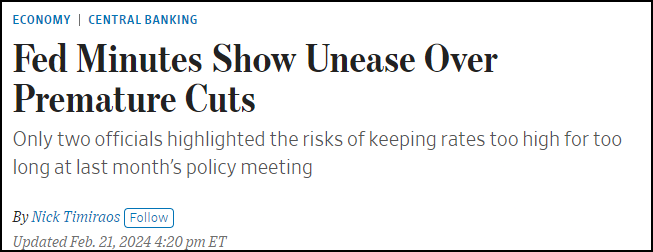

The recently released Federal Reserve minutes from the January 30-31 meeting reveal a cautious stance on monetary policy amidst various economic risks.
The Federal Reserve released the minutes from their January 30-31 meeting, providing insight into the policymakers' perspectives on the current economic landscape. The minutes revealed that officials share public concerns about various economic risks, suggesting a cautious approach to monetary policy.

The minutes highlight that the Federal Reserve is closely monitoring the commercial real estate (CRE) market, which is showing signs of stress. Elevated delinquency rates on commercial mortgage-backed securities (CMBS) continue to be a concern, particularly those backed by office properties. CRE prices, especially in the multifamily and office sectors, are declining, indicating that the market may not yet fully reflect weaker fundamentals. Low transaction levels further compound the problem, offering limited price discovery and potentially masking the extent of valuation discrepancies.
On the other hand, the Fed is also wary of inflation risks. Recent Consumer Price Index (CPI) data did not show the desired level of moderation, prompting concerns about persistent consumer price pressures. This has led to a divide within the Federal Reserve between the urgency to address inflation and the recognition of growing dangers in the CRE market.

The minutes suggest that the Fed's dual concerns are influenced by an institutional bias towards inflation fighting. Despite recognizing significant risks in the CRE market, the Fed appears hesitant to fully embrace lower interest rates due to fears of rekindling inflationary pressures. The minutes indicate that officials are prioritizing the mitigation of perceived inflation risks over other economic vulnerabilities.

The Fed's staff assessment characterized the financial system's vulnerabilities as "notable," a term suggesting significant concerns without causing alarm. High asset valuations relative to fundamentals, elevated leverage in the financial sector, and funding risks were all cited as areas of potential danger.




The minutes also acknowledged downside risks to economic growth. Some participants noted pressures on household finances, particularly among low and moderate-income families, which could pose risks to consumption outlooks. Furthermore, job gains were observed to be concentrated in certain sectors, casting doubt on the robustness of the labor market recovery.

In conclusion, the Federal Reserve's minutes reveal a complex economic picture with competing risks. While the Fed grapples with inflation concerns, it is also cognizant of the challenges posed by the CRE market and broader financial vulnerabilities. As policymakers navigate these issues, their decisions will inevitably shape the trajectory of interest rates and the overall economic environment. The market will closely watch future data releases, such as upcoming CPI figures, to gauge the Fed's policy direction in the face of these persistent economic challenges.